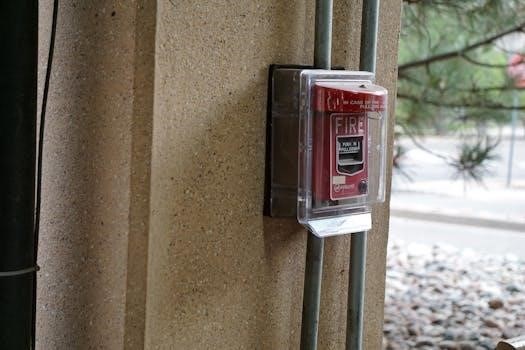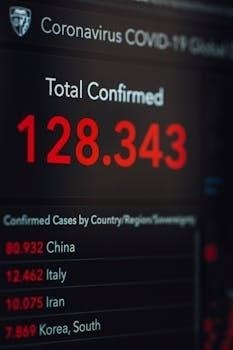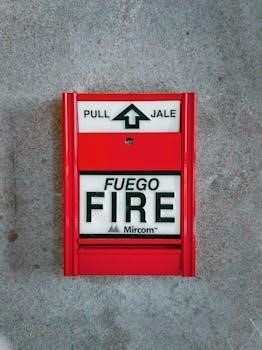First Alert carbon monoxide alarms are essential for home safety, using electrochemical sensors to detect the presence of this deadly gas. These devices, available in battery-operated and plug-in models, offer continuous monitoring.
Overview of First Alert CO Alarms
First Alert carbon monoxide alarms are designed to provide reliable and continuous monitoring of CO levels in your home. These alarms utilize electrochemical sensor technology to detect carbon monoxide, a colorless and odorless gas. Available in various models, including battery-operated and plug-in options with battery backup, these alarms ensure protection even during power outages. They are compact and user-friendly, making them easy to install and maintain. First Alert alarms are designed to meet safety standards and provide alerts when dangerous levels of CO are detected. With a focus on safety, these alarms are a crucial part of home safety systems. They are designed to be simple to use and offer a good solution to protect families from the dangers of carbon monoxide poisoning.

Key Features of First Alert Carbon Monoxide Alarms
First Alert CO alarms boast electrochemical sensors for accurate detection, battery-operated portability, and plug-in models with battery backup for continuous protection. These features enhance home safety.
Electrochemical Sensor Technology
First Alert carbon monoxide alarms utilize advanced electrochemical sensor technology to detect the presence of carbon monoxide (CO). This technology is crucial because it provides a reliable method for sensing CO, a colorless and odorless gas that is extremely dangerous. Unlike other sensor types, electrochemical sensors are specifically designed to react to carbon monoxide molecules, triggering an alarm when dangerous levels are detected. This ensures that users receive a timely warning, allowing them to take necessary precautions to avoid the potentially fatal effects of CO poisoning. The sensors provide continuous monitoring, enhancing overall safety in the home. It is an important part of the device.
Battery Operated Models
First Alert offers a range of battery-operated carbon monoxide alarms, providing flexibility and easy installation. These models are particularly useful as they ensure continuous protection even during power outages. The portability of battery-operated alarms allows them to be placed in various locations throughout the home. They utilize electrochemical sensors for reliable CO detection and are designed for easy maintenance. Battery-operated models offer a convenient and cost-effective way to enhance home safety against the dangers of carbon monoxide. They are simple to install and can be moved to different rooms as needed. The long-life batteries ensure continuous protection without frequent replacements.
Plug-in Models with Battery Backup
First Alert plug-in carbon monoxide alarms with battery backup provide a dual layer of protection, ensuring continuous monitoring even during power outages. These models plug directly into a wall outlet for primary power, and incorporate a battery backup system that activates when the power goes out. This feature ensures that the alarm remains functional in situations where the main power supply is disrupted, offering peace of mind. These plug-in models, like battery-operated ones, utilize electrochemical sensors for reliable CO detection. They are designed for easy installation and are a great choice for continuous home safety. The battery backup provides an additional layer of security in any electrical failure.

Installation and Usage
Proper installation of a First Alert carbon monoxide alarm is crucial, following manufacturer’s instructions for optimal detection. Ensure correct placement and regular testing for dependable operation.
Proper Installation Instructions
For optimal safety, always follow the specific installation instructions provided in your First Alert carbon monoxide alarm manual. Battery-operated models should be placed indoors, adhering to the manufacturer’s guidelines, ensuring they are not obstructed. Plug-in alarms should be installed in electrical outlets, and those with battery backup offer continuous monitoring. It is important to select a location that allows for easy access for testing and maintenance. Ensure that the alarm is not placed near windows, doors, or vents, as this could hinder its ability to detect carbon monoxide effectively. Furthermore, do not install the alarm in areas where it may be exposed to high levels of dust, dirt, or humidity. It’s critical to test the alarm regularly to ensure it is functioning correctly.

Alarm Functions and Indicators
First Alert carbon monoxide alarms use distinct signals to alert users of danger. Understanding these alarm signals and indicators for faults or malfunctions is critical for safety.
Understanding Alarm Signals
First Alert carbon monoxide alarms utilize specific audible and visual cues to indicate the presence of dangerous CO levels. A loud, repeating pattern of beeps typically signifies an active alarm, demanding immediate attention and action. The device may also feature a flashing light or a digital display to further indicate the alarm status. These signals are designed to be easily distinguishable from other household sounds and alerts, ensuring that occupants can quickly recognize and respond appropriately. The intensity and pattern of the signals may vary slightly depending on the specific model, so consulting the user manual is crucial for proper interpretation and understanding of what the alarm is indicating. Always familiarize yourself with the specific signals associated with your First Alert alarm.
Identifying Faults and Malfunctions
First Alert carbon monoxide alarms are designed with self-diagnostic capabilities to signal potential faults or malfunctions. Common indicators may include a consistent chirping sound, different from the alarm pattern, or a visual warning on the device’s display. These signals often indicate low battery, sensor error, or the end of the device’s lifespan. It is crucial to pay close attention to these warnings and consult the user manual for precise troubleshooting steps. Ignoring these signals could compromise the alarm’s effectiveness and leave you vulnerable to carbon monoxide exposure. Replacing batteries promptly and understanding the meaning of error codes is crucial for maintaining consistent protection. A malfunctioning alarm should be replaced immediately to ensure the safety of your home and loved ones.

Safety Information and Precautions
Understanding the risks of carbon monoxide is crucial. Proper alarm placement, regular testing, and knowing how to respond to an alarm are vital for safety. False alarm prevention is also key.
Risks of Carbon Monoxide Exposure
Carbon monoxide (CO) is an invisible, odorless, and deadly gas. It’s produced by the incomplete burning of fuels like gas, wood, propane, and oil. Exposure to CO can cause flu-like symptoms such as headaches, dizziness, nausea, and confusion. Prolonged or high-level exposure can lead to unconsciousness, brain damage, and even death. Because CO is undetectable by human senses, having a working carbon monoxide alarm is critical. The First Alert carbon monoxide alarms are designed to alert you to the presence of this dangerous gas, giving you time to react and get to safety. Without proper monitoring, individuals are at high risk of severe health consequences from CO poisoning. Therefore, a functional alarm is not just a convenience, it is a life-saving necessity.
Responding to an Alarm
When a First Alert carbon monoxide alarm sounds, it’s crucial to act quickly and calmly. The alarm signals a potentially dangerous level of CO is present. Immediately move everyone to fresh air, preferably outdoors. Do not re-enter the building until the source of the CO is identified and resolved. Call your local emergency services or fire department to assess the situation. If anyone is experiencing symptoms of CO poisoning, seek immediate medical attention. Ensure the building is thoroughly ventilated before re-entering. Remember, a carbon monoxide alarm is not a substitute for regular maintenance of fuel-burning appliances. Regular checks and proper ventilation are critical for preventing CO build-up. Never ignore a CO alarm, it could be life-saving.
False Alarm Prevention
To prevent false alarms with your First Alert carbon monoxide alarm, ensure proper installation according to the manual. Avoid placing the alarm near sources of humidity, such as bathrooms or kitchens. Keep the alarm away from direct sunlight and extreme temperatures. Regular testing of the alarm is essential to ensure it is functioning correctly and not malfunctioning. A low battery can sometimes trigger false alarms, so replace batteries promptly when alerted. If the alarm sounds and there’s no apparent source of CO, ventilate the area and ensure it’s not a temporary environmental factor. If false alarms persist, consider consulting the user manual or contact First Alert customer support; Addressing false alarms swiftly maintains trust in your alarm system.
Specific Model Information
This section provides details on specific First Alert models like the SCO500, CO400, and SC9120B. Here you can access user manuals and understand unique features for each alarm.
First Alert SCO500 and CO400 Manuals
The First Alert SCO500 and CO400 models are popular choices for carbon monoxide detection, each with specific operational guidelines. Accessing their respective manuals is crucial for proper setup and maintenance. The SCO500 manual provides detailed instructions for its combination smoke and carbon monoxide detection capabilities, while the CO400 manual focuses solely on carbon monoxide detection. These manuals typically include information on battery replacement, alarm testing procedures, and what to do in the event of an alarm. Understanding the nuances of each model, as described in their respective manuals, ensures users can effectively protect their homes and families from the dangers of carbon monoxide. It’s always recommended to consult the manuals for the most accurate and up-to-date information.
First Alert SC9120B Features
The First Alert SC9120B is a combination smoke and carbon monoxide alarm known for its reliable performance and safety features. This model integrates both smoke and carbon monoxide detection into a single unit, offering comprehensive protection. The SC9120B includes features like a loud alarm to alert occupants of danger, and battery backup to ensure continuous operation during power outages. It also includes a test button for routine checks. This model is designed to be user-friendly, with clear indicators for different alarm types, as well as low battery warnings. The SC9120B is a dependable device for those seeking dual protection against fire and carbon monoxide. It is always recommended to read the provided user manual to maximize the capabilities of the device.
Additional Resources
Online manuals for First Alert carbon monoxide alarms are readily available, providing detailed instructions for operation and troubleshooting. Visit the First Alert website for more information and support.
Accessing Online Manuals
For easy access to detailed information regarding your First Alert carbon monoxide alarm, online manuals are readily available. These digital resources provide comprehensive instructions on installation, usage, and troubleshooting. You can typically find these manuals on the official First Alert website, often within a dedicated support or product documentation section. Look for your specific model number, such as the SCO500, CO400, or SC9120B, to ensure you are accessing the correct manual. Downloading the manual allows for convenient offline access on various devices. These online manuals also provide safety information, alarm signal explanations, and guidance on preventing false alarms.
